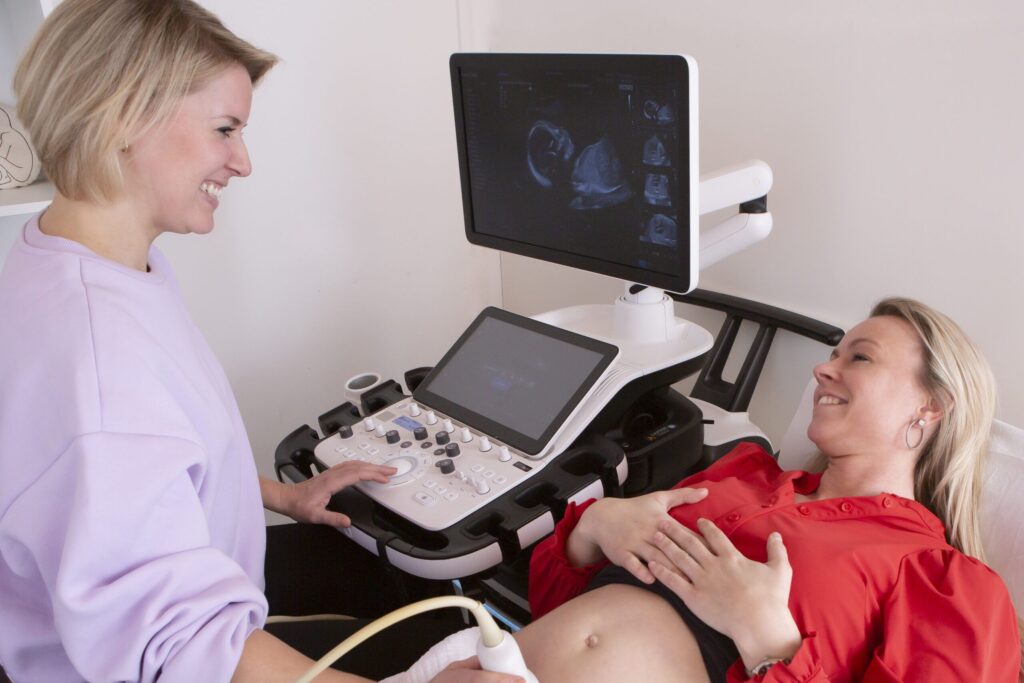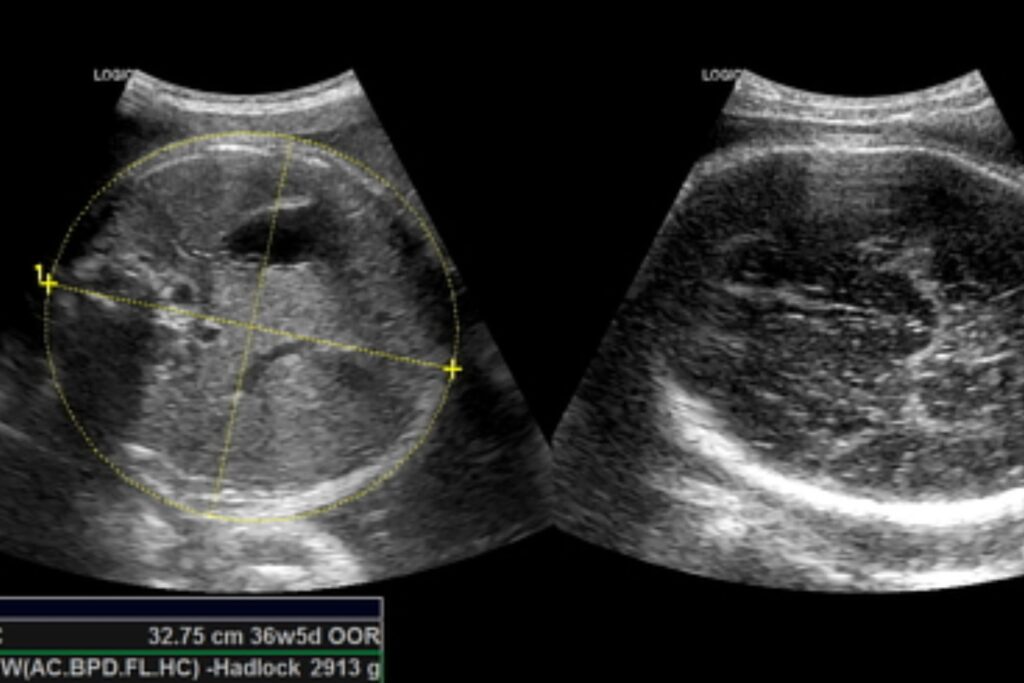What Happens During Each Trimester’s Ultrasound? A Clear Guide for Expecting Mothers
Are you expecting your first baby and wondering what really occurs during each ultrasound scan? It’s completely normal to feel a mix of excitement and nerves before these appointments. Observing your baby on the screen for the first time is an unforgettable and beautiful moment, but there’s more to it than just a precious glimpse. One and all ultrasound plays an essential role in tracking your baby’s growth, checking for any concerns, and making sure everything is on the right track. From confirming your due date in the first trimester to closely monitoring devolution in the second and checking position in the third, every scan has an aim.
In Pakistan, it’s become a lot easier over time for pregnant women to get ultrasounds, especially in cities. Even in many rural areas now, clinics and hospitals have the basic facilities. But not every place offers the same exception, so it’s worth taking the time to go somewhere you trust. The person doing your scan should be skilled and careful, it really matters.Knowing what to expect can relax your mind and help you feel more connected to the journey. Even if you’re weeks away from your first scan or already into the third trimester, understanding each step makes the expertise less overwhelming, and even more special. Let’s take a bigger look at what each stage involves.
Quick information in this blog
Why Ultrasound Scans Matter
For many expecting mothers in Pakistan, that first ultrasound is a special moment. It’s when you finally see that little heartbeat and feel, “Yes, this is real.” But there’s more to it but just a glimpse of your baby. These scans help doctors tacitly track whether everything is going readily.
In the early weeks, an ultrasound confirms your pregnancy and examines that the baby is in the right place, not outer the uterus, which can be dangerous. It also tells us how far beside you are. Later, we look closely at how your baby is growing, are the organs developing well, is there enough fluid, is the placenta doing its job?
In a country like ours, where entrance to care can vary, these scans can truly be lifesaving.They bring you closer to your baby. It’s not just medical, it’s part of your journey into motherhood.

First Trimester Ultrasound (6 to 13 Weeks)
The first scan is usually done between 6 and 9 weeks if you’re unsure of your dates or have early symptoms. This is when we confirm that you’re pregnant, check the baby’s heartbeat, and ensure the pregnancy is located in the uterus. Around 11 to 13 weeks, another scan helps us measure the baby, confirm the due date, and look for early signs of chromosomal conditions. You may be asked to have a full bladder during the first scan because it helps produce a clearer image. This is often a reassuring time for many mothers as they see the first glimpse of their baby and hear the heartbeat.
Second Trimester Ultrasound (18 to 22 Weeks)
This is also referred to as the anomaly scan. It takes longer and takes between 20 to 30 minutes. We thoroughly check the baby’s organs, brain, spine, heart, kidneys, and limbs. We check the placenta too, inspect the fluid surrounding the baby, and check up on how your baby is developing. By now, we usually know whether the baby is a boy or a girl, if you do want to know. Some parents become more attached to their baby after this scan since they can see more defined body shapes and movements.
Third Trimester Ultrasound (28 to 40 Weeks)
Not all mothers require an ultrasound in the third trimester unless there’s a cause for concern. However, we can recommend one if:.
- Your baby is smaller or larger
You had some problem with a prior pregnancy.
There’s a problem with the placenta or with the fluid levels
You might have a medical condition, like a high blood pressure or diabetes. This ultrasound test evaluates the fetal position (vertex or breech), growth development, amniotic fluid amount, and motif of umbilical blood flow. It helps determine if special delivery preparations will be required.

For fennel tea:
Use the same method with one teaspoon of fennel seeds. Strain and sip slowly.
Why it works:
Both cumin and fennel calm the digestive area. These seeds help ease gas and stomach discomfort, offering gentle, natural relief.
Stay Hydrated with Safe and Nourishing Homemade Drinks
When nausea is severe, lack of hydration makes it worse. In my clinic, I stress the importance of steady fluid intake, even small sips can protect against dehydration and fatigue.
Home‑made hydration options:
● Drink plain water throughout the day, in small but consistent amounts.
● Make salted lemonade by adding a pinch of salt and sugar to plain lemon water.
● Use ORS salts, they are available at pharmacy counters.
● Try barley water: boil one tablespoon of barley in two cups of water, strain, and sip.
Why hydrate this way:
These drinks restore electrolytes, maintain your energy, and reduce reeling. Avoid strong tea, coffee, and fizzy drinks, they can irritate your stomach.
Calm Air, Clear Head: A Hidden Trick for Nausea Relief
Many of my patients feel better simply by resting in a quiet, well-ventilated room. Fresh air reduces triggers, while soft clothing and short naps ease stress. Avoid strong smells, like kitchen smoke or perfume, that can worsen nausea. It’s a small lifestyle shift, but creating a peaceful space often brings noticeable relief, especially in the early weeks.

Understanding the Role of Doppler and Growth Scans
As your pregnancy proceeds, especially in the later weeks, doctors often recommend additional scans beyond the routine ultrasounds. Two of the most important are the Doppler scan and the growth scan. These aren’t just added steps , they help us check how well your baby is doing inside the womb.
The Doppler scan measures how well blood is extended between the placenta and your baby. It shows in case your baby is receiving sufficient oxygen and nutrients. If the blood flow is reduced, it may mean the placenta isn’t working as well as it must. This helps us act early , either with medication, rest, or closer monitoring.
The growth scan, usually done in the third trimester, checks if your baby is growing at a healthy rate. It appraises the baby’s head, abdomen, and leg bones to appraise weight and size. If a baby is too small or too large for the number of weeks, we make a care plan to support both you and your baby, sometimes adapting, diet, adding supplements like iron or protein, or recommending more rest.
Solution: If a doctor tells you to get a scan, then do your best not to worry . The tests are definitely not painful, and they don’t hurt. They are only for us to get an idea of how your baby is faring. Just make sure to show up for your appointments and follow any particular advice your doctor gives. Try to drink enough water, eat regular meals with some iron and protein , like meat, lentils, or leafy greens , and give yourself time to rest. If there is anything that is bothering you or is on your mind, then it would be if you talked to a trusted person about it. Stress can change the way you feel, and your body also requires some care from you. Normal checkups aren’t just routine , they help us catch any concerns early and keep you and your baby safe. You’re doing a great job, and you don’t have to figure it all out alone.
What If the Scan Shows Something Unexpected?
We can all agree that it is quite normal to be a little anxious before an ultrasound, particularly when you are waiting to know whether everything is okay. From a medical perspective, it’s so nice to see people who are just as excited as those I have been sitting with, and I honestly want to tell you, sometimes, experiments may reveal something that even we didn’t think of. That is not always the case that it means that something is seriously wrong.
One of many instances is the ultrasound which may be indicating that the baby’s growth is somewhat below the normal limit or the position of the placenta is lower than expected and hence further observation is required. The cases of such findings are very common, and the majority of them can be successfully treated if proper care and monitoring are provided. Several cases that I have attended to involved these conditions, whereby the deliveries went on smoothly and the babies were all healthy.
Essentially, the best thing is identifying the problem at the earliest stage possible and taking the best possible measures. This is the major advantage of frequent ultrasonic scans that they enable us to step in early and thus avoid problems. In case something does appear on your scan, I will not leave you alone. We will discuss it all out, I will definitely explain it clearly, and together we will come up with the most suitable plan for both you and your baby. No need to struggle by yourself. With the proper assistance and right information, most of the unexpected conditions can be coping effectively and calmly.
How to Prepare Before Your Ultrasound Appointment
There are a few simple things you can do before you come in for your ultrasound that will make the scanning process easier and more comfortable. First of all, find out if you need to have a full bladder. It is the case that most times, if we are doing early pregnancy scans, we ask you to drink 2 to 3 glasses of water approximately 45 minutes before your appointment. A full bladder allows us to see a clearer image of your uterus and the baby that is growing.
Put on loose-fitting and comfortable clothes. In case the scanning that will be done is abdominal, a shirt, and trousers or a shalwar kameez which you will be able to lift or adjust easily will do. You don’t have to take off all your clothes, just revealing your waist will suffice.Come a bit earlier than the agreed time so that you won’t feel rushed. Take with you any previous reports, in particular, if this is not your first scan. These details help us refer and track your baby’s growth over time.
In the case that you are feeling worried, try to talk to someone who can understand you or even have a family member accompany you for moral support. It is perfectly fine to have questions, if you cannot remember them all just write them down. I am always encouraging the mothers who are expecting to ask whatever they feel like. You are not just there for obtaining the scan, you are there to understand and connect with your baby. Let’s make the experience a tranquil and joyful one.
Extra Tip 2: Avoid Heavy, Greasy, or Strongly Spiced Foods
Pakistanis love oily food, but when nausea strikes, nothing heavier than lightly spiced meals should go near your stomach.
How to adapt your meals:
● Skip fried snacks like samosas or pakoras.
● Don’t eat spicy biryanis or curries.
● Use minimal oil and spices in khichdi, daal, or boiled vegetables.
● For proteins, go for grilled or boiled chicken instead of deep-fried.
These mild meals reduce digestive stress and help you stay healthy without triggering nausea.
Final Thoughts
As a doctor, I believe informed mothers make stronger decisions. Ultrasound scans are a key part of your care. They allow us to celebrate your baby’s progress while also being alert to anything that needs attention.My message to all expecting mothers in Pakistan is this: Don’t be afraid to ask questions. Trust your body, trust your doctor, and stay involved in your care. You’re doing something beautiful, bringing new life into this world, and you deserve clear guidance and gentle reassurance at every stage.If you have not yet made up your mind about the schedule of your scans on the result it’s best to consult your gynecologist. You have all the support you could have on this journey.
FREQUENTLY ASKED QUESTIONS
When is the first ultrasound done?
Usually between 6 to 9 weeks. It confirms your pregnancy, checks the heartbeat, and makes sure the baby is in the uterus.
What’s checked in the second trimester scan?
Around 18 to 22 weeks, we check the baby’s organs, growth, and overall development. Gender can also be seen if you want to know.
Is a third-trimester scan needed?
Only if there’s a concern, like slow growth, low fluid, or a health condition in the mother. It checks the baby’s position and well-being.
What is a Doppler scan?
It checks blood flow from the placenta to the baby. It’s done if there are concerns about growth or oxygen supply.
Why do a growth scan?
To see if the baby is growing at the right rate. We measure the head, belly, and legs to check size and weight.
